Global Discoveries on DVD: Sometimes (Matters Arising)
By Jonathan Rosenbaum
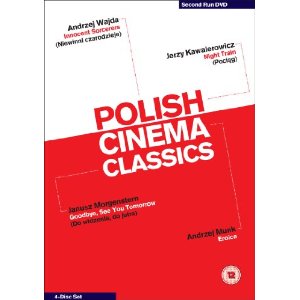 1. Two special four-disc sets have become available this quarter to fill in sizable gaps in our grasp of Eastern European cinema during the mid-20th century. First, Polish Cinema Classics from Second Run in the UK, gathering together Andrzej Munk’s Eroica (1957), Jerzy Kawalerowicz’s Night Train (1959), Andrzej Wajda’s Innocent Sorcerors (1960), and Janusz Morgenstern’s Goodbye, See You Tomorrow (1960), all of which have accompanying booklets and all but the last of which come with significant, on-disc extras; and then Pearls of the Czech New Wave from Criterion/Eclipse in the US, including Pearls of the Deep (five adaptations of short stories by Bohumil Hrabal by Věra Chytilová, Jaromil Jireš, Jiří Menzel, Jan Němec, and Evald Schorm, 1966), Chytilová’s Daisies (1966), Němec’s A Report on the Party and Guests (1966), Schorm’s Return of the Prodigal Son (1967), Menzel’s Capricious Summer (1968), and Jireš’ The Joke (1969). (The latter set has no on-disc extras, which is usual for Eclipse, but Michael Koresky, Criterion’s in-house scribe, has furnished informative notes about every feature.)
1. Two special four-disc sets have become available this quarter to fill in sizable gaps in our grasp of Eastern European cinema during the mid-20th century. First, Polish Cinema Classics from Second Run in the UK, gathering together Andrzej Munk’s Eroica (1957), Jerzy Kawalerowicz’s Night Train (1959), Andrzej Wajda’s Innocent Sorcerors (1960), and Janusz Morgenstern’s Goodbye, See You Tomorrow (1960), all of which have accompanying booklets and all but the last of which come with significant, on-disc extras; and then Pearls of the Czech New Wave from Criterion/Eclipse in the US, including Pearls of the Deep (five adaptations of short stories by Bohumil Hrabal by Věra Chytilová, Jaromil Jireš, Jiří Menzel, Jan Němec, and Evald Schorm, 1966), Chytilová’s Daisies (1966), Němec’s A Report on the Party and Guests (1966), Schorm’s Return of the Prodigal Son (1967), Menzel’s Capricious Summer (1968), and Jireš’ The Joke (1969). (The latter set has no on-disc extras, which is usual for Eclipse, but Michael Koresky, Criterion’s in-house scribe, has furnished informative notes about every feature.)
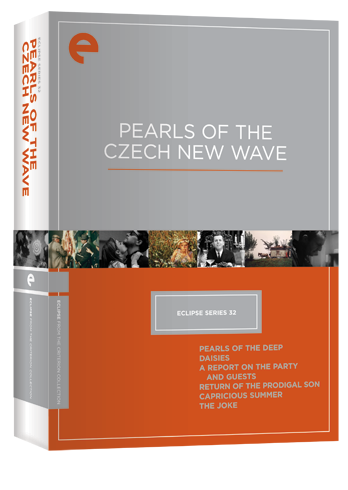 So far, I’ve only had time to watch Night Train (for the first time) in the first set, a claustrophobic tour de force for nearly all of its running time that made me wonder if Polanski’s Knife in the Water three years later might have been conceived in part as a comparable kind of technical stunt; and Chytilová’s The Restaurant the World in Pearls of the Deep, a rather obscure black-and-white sketch made shortly before Daisies. Speaking of which, this is the third edition of an English-subtitled Daisies, after previous versions from Facets Video and Second Run, which makes me disappointed that Eclipse didn’t opt instead for Chytilová’s brilliant and innovative first feature, Something Different (1963)—cited by Rivette in his famous “Montage” text and clearly a significant formal influence on his subsequent Out 1: Spectre (1974)—which as far as I know still can’t be found anywhere.
So far, I’ve only had time to watch Night Train (for the first time) in the first set, a claustrophobic tour de force for nearly all of its running time that made me wonder if Polanski’s Knife in the Water three years later might have been conceived in part as a comparable kind of technical stunt; and Chytilová’s The Restaurant the World in Pearls of the Deep, a rather obscure black-and-white sketch made shortly before Daisies. Speaking of which, this is the third edition of an English-subtitled Daisies, after previous versions from Facets Video and Second Run, which makes me disappointed that Eclipse didn’t opt instead for Chytilová’s brilliant and innovative first feature, Something Different (1963)—cited by Rivette in his famous “Montage” text and clearly a significant formal influence on his subsequent Out 1: Spectre (1974)—which as far as I know still can’t be found anywhere.
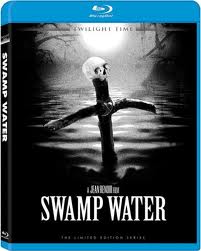 2. Sometimes the most valuable thing that criticism can do is change the terms of a discussion. So I’m especially grateful to Dave Kehr and his Sunday column in The New York Times, not only for alerting me to the limited editions of Twilight Time in general (screenarchives.com; see below) and their Blu-ray of Jean Renoir’s Swamp Water (1941) in particular, but also for changing the terms of my reading of Renoir’s first Hollywood picture, which I hadn’t reseen in years. (I’m also grateful to Kehr’s column for recommending Something to Live For, an affecting and grim 1952 George Stevens melodrama recently released by Olive Films, which appears to resemble other Stevens films only in its languid lap dissolves.)
2. Sometimes the most valuable thing that criticism can do is change the terms of a discussion. So I’m especially grateful to Dave Kehr and his Sunday column in The New York Times, not only for alerting me to the limited editions of Twilight Time in general (screenarchives.com; see below) and their Blu-ray of Jean Renoir’s Swamp Water (1941) in particular, but also for changing the terms of my reading of Renoir’s first Hollywood picture, which I hadn’t reseen in years. (I’m also grateful to Kehr’s column for recommending Something to Live For, an affecting and grim 1952 George Stevens melodrama recently released by Olive Films, which appears to resemble other Stevens films only in its languid lap dissolves.)
I’ve always preferred Swamp Water to Renoir’s far more prestigious (if probably less commercially profitable) The Southerner—his second American feature with a Southern and rural setting, made four years later—because, as a native of Alabama, the earlier film has always seemed more authentic and believable to me in its Southern details, despite its obvious studio trappings and despite the fact that The Southerner had William Faulkner as an uncredited advisor. (For whatever it’s worth, James Agee also had trouble accepting The Southerner as Southern.) And I would still insist on this difference, even when the ethnic stereotyping in Swamp Water verges at times on Li’l Abner; at least it has a poetic rightness of a kind that The Southerner lacks, and some of the performances (especially those of Dana Andrews, Walter Huston, and Walter Brennan) are simply too good for serious qualms to intervene. From an auteurist perspective, however, many objections and demurrals have been raised towards Swamp Water over the years; Alexander Sesonske once even published a well-researched study in The Georgia Review (which I no longer have handy, alas) that throws considerable doubt on whether it should even be regarded as a Renoir film in the first place.
Kehr’s analysis contends that the film is personal despite these demurrals, and I must say that from the moment that Mary Howard in an early scene expresses her lust for Walter Huston (as her older husband), we clearly seem to be somewhere other than the glossy Fox studio conventions of 1941; the same goes for Dana Andrews’ hillbilly accent. Indeed, despite the Dudley Nichols script, more John Ford regulars than you can shake a stick at, and the frequent strains of “Red River Valley” in the score (all duly noted by Julie Kirgo in her liner notes), Swamp Water is anything but Fordian in its visual or acting styles. What Kehr does to change the terms of the discussion is to relate the film to period more than place—specifically, to the films of the French Occupation that were made shortly afterwards (Les visiteurs du soir [1942], Le corbeau and Lumière d’été [both 1943]) in terms of their pessimistic view of human nature and dark social atmosphere (including paranoia), a context which ultimately has many spatial as well as ideological ramifications.
Two unrelated postscripts: (1) Before my next column, Eclipse should be bringing out Lumière d’été and two other important Jean Grémillon films made during the Occupation, Remorques (1941) and Le ciel est à vous (1944). (2) Since I wrote the above paragraphs, Twilight Time has kindly sent me two more Blu-rays of ’50s Hollywood pictures, once again reflecting their separate auteurist and non-auteurist strains: Fritz Lang’s The Big Heat (1953), a classic noir starring Glenn Ford, Gloria Grahame, and Lee Marvin, and Henry Levin’s Journey to the Center of the Earth (1959), a Jules Verne adaptation in CinemaScope starring Pat Boone, James Mason, and Arlene Dahl that I recall enjoying in my teens. Both come outfitted, as do most of their other releases, with the original theatrical trailer and an isolated musical score track.
3. A periodic drawback to this column is my inability to gauge what’s about to go out of circulation. So I’m sorry to say that “Gaumont’s French DVD of JLG/JLG: Autoportrait de Décembre (1994), coupled with five important Godard shorts, which also boasts English subtitles,” written about in my last column, which I purchased from a store in Paris, is no longer readily available now, according to a Canadian correspondent, Blaine Allan. More recently, however, it seems to have turned up again, at http://boutique.gaumont.fr/index.php?page=produit&id=72457.
4. Given my nostalgic taste for ’50s and ’60s Hollywood, Twilight Time’s online catalogue of “limited edition” Blu-rays (“only 3,000 units available”) is a welcome discovery, and I set about requesting their editions of Desiree (1954) and Bell, Book and Candle (1958), which attracted me above all for their actors: Marlon Brando (as Napoleon, no less) and Jean Simmons, the future costars of Guys and Dolls (1955), in the first, and Kim Novak and James Stewart, the co-stars of Vertigo earlier that same year, not to mention Ernie Kovacs at his funniest, in the second. The only problem with Desiree is that, star chemistry or not, Henry Koster was the director, and Brando seems almost as bored by the direction as I was with watching him. Fortunately, Richard Quine, the director of the second, was no Koster, and does a fine job with his light material, his Manhattan atmospherics, and both his stars, despite the periodic interruptions of the characteristically hectoring Jack Lemmon. There are also, as extras, offscreen interviews with Novak about both this movie and Middle of the Night (1959), clearly two of her favourites among her pictures at Columbia.
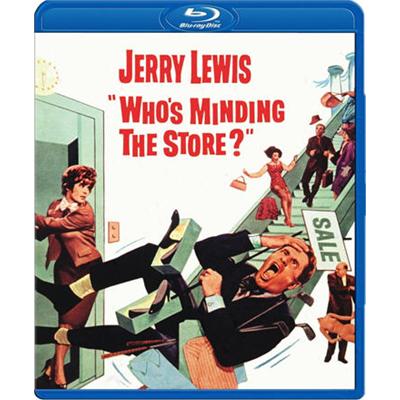 5. Sometimes it’s almost as hard to distinguish two Frank Tashlin films from one another in memory as it is to distinguish between two films by Ozu Yasujiro. Case in point: I could have sworn that the culminating gag of Tashlin’s Who’s Minding the Store? (1963), recently re-released by Olive Films, consisted of a fleet of shopping carts running amok, but in fact this turns out to the culminating gag of Tashlin’s The Disorderly Orderly the following year. In point of fact, the culminating gag of Who’s Minding the Store?—even more brilliant and hilarious, both for its developments and for its metaphorical aptness in representing capitalistic delirium in all its monstrous splendour—consists of a single vacuum cleaner running amok in Tuttle’s Department Store, the film’s central location, meanwhile taking almost all of the store’s goods and surrounding animal life into its expanding belly.
5. Sometimes it’s almost as hard to distinguish two Frank Tashlin films from one another in memory as it is to distinguish between two films by Ozu Yasujiro. Case in point: I could have sworn that the culminating gag of Tashlin’s Who’s Minding the Store? (1963), recently re-released by Olive Films, consisted of a fleet of shopping carts running amok, but in fact this turns out to the culminating gag of Tashlin’s The Disorderly Orderly the following year. In point of fact, the culminating gag of Who’s Minding the Store?—even more brilliant and hilarious, both for its developments and for its metaphorical aptness in representing capitalistic delirium in all its monstrous splendour—consists of a single vacuum cleaner running amok in Tuttle’s Department Store, the film’s central location, meanwhile taking almost all of the store’s goods and surrounding animal life into its expanding belly.
By depressing contrast, I’m afraid that the lawnmowers running amok at the anemic climax of Tashlin and Lewis’ It’s Only Money (1962), another recent Olive release, is neither satiric nor funny, although the script in this case (signed only by John Fenton Murray) is so threadbare that these sad little props are brought back as an encore in the film’s final shot. This isn’t the only problem here: Zachary Scott’s clunky sense of physical comedy and the black-and-white photography aren’t very helpful either. Which only serves to demonstrate yet again that auteurist persistence can sometimes work as a liability. Another example of this: Lewis plays a TV repairman in both one of the very best of his eight Tashlin films (Rock-a-bye Baby, 1958) and in the probable worst of the lot (It’s Only Money). But at least I can make it to the bitter end of the latter—something I can’t quite manage with Tashlin’s Lewis-less penultimate feature, Caprice (1967), out from Second Sight in the UK.
6. Sometimes the outsized faith placed in most contemporary viewers on the Internet Movie Database and/or Wikipedia merely works as a guarantee that historical accuracy remains short-changed, confused, obfuscated. A good example of what I mean are the two versions of Wim Wenders’ 1980 film with and about himself and Nicholas Ray (the latter during his final weeks)—the first edited by Peter Przygodda, 116 minutes long, which premiered in Cannes in May 1980 and was known to me, at least originally, as Nick’s Movie. (I initially saw this at a private screening in New York, held by Wenders shortly before the Cannes premiere.) The second film was edited by Wenders, is 91 minutes long, and premiered (I think) in Germany later the same year, in November, and is usually known as Lightning Over Water.
What makes this so confusing is that most print sources, including Patrick McGilligan’s recent Nicholas Ray: The Glorious Failure of an American Director, collapse the two films and two titles into a single object; the version currently being sold for only $2.89 on Amazon, from Anchor Bay, calls it Nick’s Film—Lightning Over Water, to muddle things even further. (I presume this is identical to the PAL DVD that I own from bacfilms.com, now out of print, which is called Nick’s Movie. This DVD, incidentally, includes 38 minutes of Ray’s Q & A at the Museum of Modern Art when he was brought onstage in a wheelchair; I was present at that event, although my question about how he felt about being filmed and his guarded answer didn’t make the final cut.) Only Bernard Eisenschitz’s ever-reliable Nicholas Ray: An American Journey gets it right by identifying the two films, respectively, as “first version” and “definitive version.”
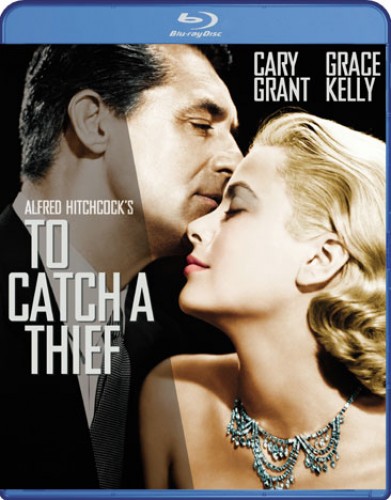 7. As entertaining as I find the Blu-ray of To Catch a Thief (1955), above all for its vibrant colour palette (in particular the bold and unusual use of green filters for night-time exteriors) and for the sarcastic rebukes to audience reflexes in its opening and closing gags, this film has got to be the closest Alfred Hitchcock ever got to making a stinker in the 1950s. Since the colours, green included, seldom mean or do anything at all (apart from function as travel-poster décor), as they do in all the better Hitchcock movies, the sensual pleasures here, also including the lush landscapes, wind up as appetizers for a main course that never materializes. And even though the film has far too many compensations to qualify as a complete washout (including the sheer craft of convincing an audience that this half-studio-shot effort was all filmed in France), and despite the irritatingly thin superficialities of all the characters (Cary Grant and Grace Kelly included), this movie still qualifies as the major piece of counter-evidence against the Cahiers du Cinéma polemic that Hitchcock was a serious artist worth taking seriously (which is plainly how André Bazin regarded it, recoiling from the claims of his young disciples)—despite a lengthy section in Raymond Durgnat’s book on the director that gets a surprising amount of mileage out of the film’s nuances. Most of the extras here— including a half-hearted effort to identify a few of the Côte d’Azur locations in an interactive feature—qualify as blatant padding. (Most egregious of all is an “appreciation” of the movie by the hack responsible for most of the studio-era “making-of” documentaries that chiefly consists of Hitchcock’s family home movies.) But for entertainment as opposed to art, this certainly has its moments.
7. As entertaining as I find the Blu-ray of To Catch a Thief (1955), above all for its vibrant colour palette (in particular the bold and unusual use of green filters for night-time exteriors) and for the sarcastic rebukes to audience reflexes in its opening and closing gags, this film has got to be the closest Alfred Hitchcock ever got to making a stinker in the 1950s. Since the colours, green included, seldom mean or do anything at all (apart from function as travel-poster décor), as they do in all the better Hitchcock movies, the sensual pleasures here, also including the lush landscapes, wind up as appetizers for a main course that never materializes. And even though the film has far too many compensations to qualify as a complete washout (including the sheer craft of convincing an audience that this half-studio-shot effort was all filmed in France), and despite the irritatingly thin superficialities of all the characters (Cary Grant and Grace Kelly included), this movie still qualifies as the major piece of counter-evidence against the Cahiers du Cinéma polemic that Hitchcock was a serious artist worth taking seriously (which is plainly how André Bazin regarded it, recoiling from the claims of his young disciples)—despite a lengthy section in Raymond Durgnat’s book on the director that gets a surprising amount of mileage out of the film’s nuances. Most of the extras here— including a half-hearted effort to identify a few of the Côte d’Azur locations in an interactive feature—qualify as blatant padding. (Most egregious of all is an “appreciation” of the movie by the hack responsible for most of the studio-era “making-of” documentaries that chiefly consists of Hitchcock’s family home movies.) But for entertainment as opposed to art, this certainly has its moments.
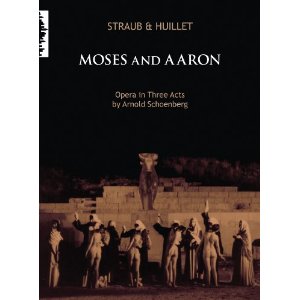 8. Moses and Aron, Jean-Marie Straub and Danièle Huillet’s 1975 film of Arnold Schönberg’s twelve-tone opera, is far from being my favourite Straub-Huillet feature, if only because its work on landscape has for me been largely superseded by such later films of theirs as Trop tôt, trop tard (1981, still woefully unavailable on DVD, even in Europe, reportedly due to problems with the original negative), Schwarze Sünde (1988), and Operai, contadini (2001), among several others. But I have to admit that Cindi Rowell, who produced the DVD for New Yorker Video, has made all the right decisions in her choice of accompanying materials—e.g., the complete libretto in both German and English, an essential aid in following how Straub and Huillet chose to interpret the stage directions; Allen Shawn’s useful and elegant 2008 essay; an excellent bibliography; and, on disc, Straub-Huillet’s extraordinary 1973 Introduction to Arnold Schönberg’s “Accompaniment to a Cinematographic Scene,” one of their very best short films.
8. Moses and Aron, Jean-Marie Straub and Danièle Huillet’s 1975 film of Arnold Schönberg’s twelve-tone opera, is far from being my favourite Straub-Huillet feature, if only because its work on landscape has for me been largely superseded by such later films of theirs as Trop tôt, trop tard (1981, still woefully unavailable on DVD, even in Europe, reportedly due to problems with the original negative), Schwarze Sünde (1988), and Operai, contadini (2001), among several others. But I have to admit that Cindi Rowell, who produced the DVD for New Yorker Video, has made all the right decisions in her choice of accompanying materials—e.g., the complete libretto in both German and English, an essential aid in following how Straub and Huillet chose to interpret the stage directions; Allen Shawn’s useful and elegant 2008 essay; an excellent bibliography; and, on disc, Straub-Huillet’s extraordinary 1973 Introduction to Arnold Schönberg’s “Accompaniment to a Cinematographic Scene,” one of their very best short films.
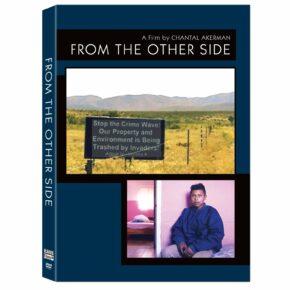 9. Speaking of landscape, while writing the above paragraph I was delighted to receive a copy of Icarus Films Home Video’s DVD of Chantal Akerman’s masterful and timely film about illegal Mexican aliens, From the Other Side (2002), a documentary that for me is second only to her 1993 From the East (also available from Icarus). I wish I felt the same way about South (1999), focusing on a hideous racial murder in Jasper, Texas, which Akerman made in between From the East and From the Other Side, and which Icarus includes as a bonus to the latter on a second disc, but here I don’t see her having anything significant to add to other documentaries on topics of this kind.
9. Speaking of landscape, while writing the above paragraph I was delighted to receive a copy of Icarus Films Home Video’s DVD of Chantal Akerman’s masterful and timely film about illegal Mexican aliens, From the Other Side (2002), a documentary that for me is second only to her 1993 From the East (also available from Icarus). I wish I felt the same way about South (1999), focusing on a hideous racial murder in Jasper, Texas, which Akerman made in between From the East and From the Other Side, and which Icarus includes as a bonus to the latter on a second disc, but here I don’t see her having anything significant to add to other documentaries on topics of this kind.
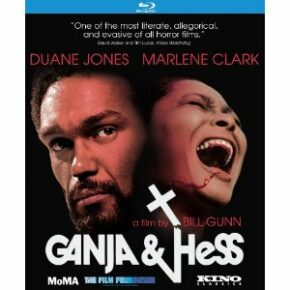 10. Ganja & Hess on Blu-ray from Kino Lorber. Here’s what I wrote for Time Out London from Cannes in 1973, after catching the premiere of this singular first feature: “Bill Gunn’s Ganja & Hess in the Critics’ Week is an impenetrable but fascinating curiosity—often dull but never predictable, technically uncertain yet wholly distinctive. It also represents something of a historical precedent in that it was produced, written, directed and acted by American blacks and makes no commercial concessions of any kind. Gunn introduced the film by saying, ‘We’re not yet allowed to make personal films—so I was offered a vampire movie to do instead. When they came back, this is what they found.’ Verbose and theatrical in spots, not even remotely Gothic or scary, Gunn’s film relates vampirism both to black religion and to an African past, dealing with a black aristocrat, played poker-faced by Duane Jones, who ‘lives in a world of dead objects left by a civilization that isn’t his own.’” Among the many extras here are a half-hour “making-of” documentary done for the 1998 DVD release, Gunn’s original screenplay (on BD-ROM), and an audio commentary by four people who worked on the film.
10. Ganja & Hess on Blu-ray from Kino Lorber. Here’s what I wrote for Time Out London from Cannes in 1973, after catching the premiere of this singular first feature: “Bill Gunn’s Ganja & Hess in the Critics’ Week is an impenetrable but fascinating curiosity—often dull but never predictable, technically uncertain yet wholly distinctive. It also represents something of a historical precedent in that it was produced, written, directed and acted by American blacks and makes no commercial concessions of any kind. Gunn introduced the film by saying, ‘We’re not yet allowed to make personal films—so I was offered a vampire movie to do instead. When they came back, this is what they found.’ Verbose and theatrical in spots, not even remotely Gothic or scary, Gunn’s film relates vampirism both to black religion and to an African past, dealing with a black aristocrat, played poker-faced by Duane Jones, who ‘lives in a world of dead objects left by a civilization that isn’t his own.’” Among the many extras here are a half-hour “making-of” documentary done for the 1998 DVD release, Gunn’s original screenplay (on BD-ROM), and an audio commentary by four people who worked on the film.
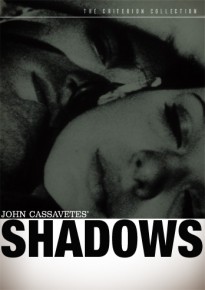 11. A few comparisons between the Criterion and BFI editions of Cassavetes’ Shadows (1959):
11. A few comparisons between the Criterion and BFI editions of Cassavetes’ Shadows (1959):
The Criterion DVD has 2004 interviews with Seymour Cassel and Lelia Goldoni; BFI’s “dual-format edition” (including both a DVD and a Blu-ray) has a new audio commentary by critic Tom Charity and Cassel on both and a 13-minute 1993 interview with Peter Falk (by Paul Joyce, for British TV) about Cassavetes’ “early years” on the DVD; also on the DVD (but not on the Blu-ray) and on the Criterion DVD as well are the film’s theatrical trailer (a period curiosity, featuring quotes from critics like Dwight Macdonald and some brief portions of the Charlie Mingus score that, if I’m not mistaken, don’t appear in the film itself) and four minutes of 16mm footage of Cassavetes and Burt Lane’s acting workshop. Both editions use the UCLA restoration, although, if it matters, the credits for this appear at the beginning of the BFI version and at the end of the Criterion version.
An interesting similarity between the Falk interview and the Charity/Cassel audio commentary: in both cases, the professional actor seems to remember dates and other kinds of information only approximately and vaguely (for instance, Falk seems to think that Cassavetes conceived of Shadows in 1957 long before anyone ever heard of Martin Luther King, but in fact the Montgomery bus boycott, spearheaded by King and Rosa Parks, occurred two years earlier), while the journalist (Charity and Joyce) in each case tends to be much more scholarly and precise. This becomes rather comical when disagreements between Cassel and Charity keep coming up about which scenes were and weren’t in the original 1957 version. (Charity, like me, was lucky enough to see the 1957 version when it was screened by Ray Carney at the Rotterdam film festival in 2004, whereas Cassel was around when both versions were shot but apparently hasn’t seen the 1957 version since the ’50s).
 12. I haven’t been able to convince myself yet to resee Godzilla (Ishiro Honda, 1954), issued by Criterion in a two-disc package—although, to tell the truth, I’d much rather revisit this 96-minute monster flick than return to any part of Bernardo Bertolucci’s 315-minute 1900 (1977), just issued on Blu-ray by Olive Films. But I’ve had a great time reading J. Hoberman’s essay about Godzilla in the Criterion set (a piece that shows Hoberman’s mythological/sociological bents at their near-best), and at least a tolerable time watching, on a DVD included with the two 1900 Blu-rays, Sandro Lai’s 52-minute What’s the Purpose of Cinema? (2002), a perfunctory montage culled from Bertolucci’s interviews with RAI from the early ’60s through the shooting of Besieged (1998) in the mid-’90s.
12. I haven’t been able to convince myself yet to resee Godzilla (Ishiro Honda, 1954), issued by Criterion in a two-disc package—although, to tell the truth, I’d much rather revisit this 96-minute monster flick than return to any part of Bernardo Bertolucci’s 315-minute 1900 (1977), just issued on Blu-ray by Olive Films. But I’ve had a great time reading J. Hoberman’s essay about Godzilla in the Criterion set (a piece that shows Hoberman’s mythological/sociological bents at their near-best), and at least a tolerable time watching, on a DVD included with the two 1900 Blu-rays, Sandro Lai’s 52-minute What’s the Purpose of Cinema? (2002), a perfunctory montage culled from Bertolucci’s interviews with RAI from the early ’60s through the shooting of Besieged (1998) in the mid-’90s.
13. A memo to Criterion: I know that everyone and her or his uncle has a suggestion about what sets should be released on Criterion’s no-frills Eclipse label, but I’d like to focus briefly on a possibility that I don’t believe anyone else is even considering. Last night I re-saw—I won’t say how— Susan Sontag’s first feature Duet for Cannibals (1969), for the first time since it came out 43 years ago, and even though I wouldn’t call it an unqualified success, it certainly hasn’t aged badly either. The fact that it co-stars the wonderful Adriana Asti, who figures prominently in both Bertolucci’s Before the Revolution (1964) and André Téchiné’s Unforgivable last year, already makes it well worth seeing. I recall that Brother Carl (1971), Sontag’s far more ambitious second feature, is even more interesting, and I’ve never had an opportunity to see her final film, Letter from Venice a.k.a. Unguided Tour (1983).
Indeed, I can hardly think of another contemporary filmmaker whose films have been more difficult to see. And I suspect that targeting may have some relation to this problem: Sontag may have been the American literary figure of the 20th century who had the greatest sophistication (by far) about film, but this distinction doesn’t translate into any particular niche market because film buffs and literary types rarely occupy the same spheres. Nevertheless, now that we finally have a good DVD edition of Sontag’s Promised Lands (1974), her non-fiction film about the 1973 Yom Kippur War, available from Zeitgeist and Kimstim—which I blogged about early last year at www.jonathanrosenbaum.com/?p=24291, and which clearly also looks a lot better now than it once did—Criterion would obviously be doing many of us an enormous favour if they could furnish us with the remainder of her film work in an affordable package.
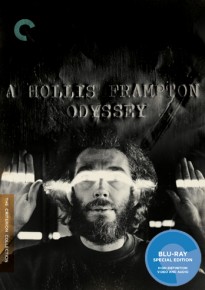 14. Meanwhile, Criterion’s two-disc A Hollis Frampton Odyssey, with an elaborate 42-page booklet, is a major contribution to culture, full stop. (So, for that matter, is their recent two-disc release of Anatomy of a Murder [1959], Otto Preminger’s greatest feature, but I can’t imagine that readers of this column need my recommendation to make a beeline for this treasure.) I blush to admit that I still barely know Frampton’s work, apart from his best-known blockbusters—such as my favourite among these, the 1971 (nostalgia), already available in American Film Treasures IV: Avant-Garde 1947-1986. Even though I attended the infamous premiere of Zorns Lemma (1970) at the New York Film Festival, I was living in places where his work was mainly out of reach during all but the first three and last three years covered in this collection (1966-1979). But I’m hardly alone in this deficiency: when Godard first read Frampton’s 1971 essay “For a Metahistory of Film” in French translation in Trafic in 1997 and wanted to reprint it for a publication he was putting together to promote his Histoire(s) du cinéma in Cannes, he didn’t even know at the time that Frampton had died 14 years earlier. So I’m clearly one of the people that this set was made for, and from this standpoint I can only regret that Frampton’s Hapax Legomena cycle (1971-72) of seven films—which includes Critical Mass, (nostalgia), and Poetic Justice—includes those three titles but not the four others.
14. Meanwhile, Criterion’s two-disc A Hollis Frampton Odyssey, with an elaborate 42-page booklet, is a major contribution to culture, full stop. (So, for that matter, is their recent two-disc release of Anatomy of a Murder [1959], Otto Preminger’s greatest feature, but I can’t imagine that readers of this column need my recommendation to make a beeline for this treasure.) I blush to admit that I still barely know Frampton’s work, apart from his best-known blockbusters—such as my favourite among these, the 1971 (nostalgia), already available in American Film Treasures IV: Avant-Garde 1947-1986. Even though I attended the infamous premiere of Zorns Lemma (1970) at the New York Film Festival, I was living in places where his work was mainly out of reach during all but the first three and last three years covered in this collection (1966-1979). But I’m hardly alone in this deficiency: when Godard first read Frampton’s 1971 essay “For a Metahistory of Film” in French translation in Trafic in 1997 and wanted to reprint it for a publication he was putting together to promote his Histoire(s) du cinéma in Cannes, he didn’t even know at the time that Frampton had died 14 years earlier. So I’m clearly one of the people that this set was made for, and from this standpoint I can only regret that Frampton’s Hapax Legomena cycle (1971-72) of seven films—which includes Critical Mass, (nostalgia), and Poetic Justice—includes those three titles but not the four others.
(A late postscript: One Frampton specialist has assured me, however, that these four films work less well in their digital forms.)
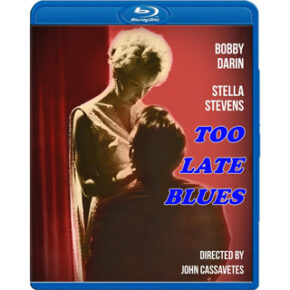 15. Despite some rather high-flown sentiments on their website (olivefilms.com/about-us/#), labelled alternately “Our Story” (“How We Got Here!”) and “Our Philosophy” (“How We Think!”), some of which seem to come dangerously close to gibberish, I hope the executives of Olive Films will forgive me if I continue to be a little confounded by the logic and range of their selections, even though the possibility that some of these may be arbitrary may actually be welcome. (During the first weeks of my extended sojourn in Paris during the late 1960s, I recall that some of Henri Langlois’ most interesting programming at the Paris Cinémathèque appeared to be quite random, determined more by sheer curiosity than any critical or scholarly impulses.) So I’m basically pleased that recent (including forthcoming) Olive releases include, on Blu-ray only, two of the three early ’50s westerns written by Frank Gruber, directed by Byron Haskin, and starring Edmond O’Brien—Silver City (1951) and Denver & Rio Grande (1952)—but not the 1951 Warpath (most likely, I saw all three of these while I was in grammar school, but remember zilch about them today); on Blu-ray and DVD, John Cassavetes’ wonderful and awful second feature, Too Late Blues (1962) in a lovely transfer, Nicholas Ray’s mediocre 1955 western Run for Cover (his only VistaVision picture) in a lousy transfer (or maybe just working from lousy source material), and, not yet received, Don Siegel’s imperishable Invasion of the Body Snatchers (1956); and finally, on DVD only, Joseph Losey’s The Lawless (1950), which I recall as interesting; and what I would describe as Jean-Luc Godard’s two best and most important political films: Numéro deux (1975), made with Anne-Marie Miéville, and Ici et ailleurs (1976), started with Jean-Pierre Gorin and then completed years later with Miéville. In short, some very strange combos.
15. Despite some rather high-flown sentiments on their website (olivefilms.com/about-us/#), labelled alternately “Our Story” (“How We Got Here!”) and “Our Philosophy” (“How We Think!”), some of which seem to come dangerously close to gibberish, I hope the executives of Olive Films will forgive me if I continue to be a little confounded by the logic and range of their selections, even though the possibility that some of these may be arbitrary may actually be welcome. (During the first weeks of my extended sojourn in Paris during the late 1960s, I recall that some of Henri Langlois’ most interesting programming at the Paris Cinémathèque appeared to be quite random, determined more by sheer curiosity than any critical or scholarly impulses.) So I’m basically pleased that recent (including forthcoming) Olive releases include, on Blu-ray only, two of the three early ’50s westerns written by Frank Gruber, directed by Byron Haskin, and starring Edmond O’Brien—Silver City (1951) and Denver & Rio Grande (1952)—but not the 1951 Warpath (most likely, I saw all three of these while I was in grammar school, but remember zilch about them today); on Blu-ray and DVD, John Cassavetes’ wonderful and awful second feature, Too Late Blues (1962) in a lovely transfer, Nicholas Ray’s mediocre 1955 western Run for Cover (his only VistaVision picture) in a lousy transfer (or maybe just working from lousy source material), and, not yet received, Don Siegel’s imperishable Invasion of the Body Snatchers (1956); and finally, on DVD only, Joseph Losey’s The Lawless (1950), which I recall as interesting; and what I would describe as Jean-Luc Godard’s two best and most important political films: Numéro deux (1975), made with Anne-Marie Miéville, and Ici et ailleurs (1976), started with Jean-Pierre Gorin and then completed years later with Miéville. In short, some very strange combos.
16. Nineteen euros is a lot to pay for a DVD, and this is what Frédéric Sojcher’s intriguingly titled Hitler à Hollywood/Hitler in Hollywood (2010), complete with English subtitles, will cost you on French Amazon (and for a little more, you can order it directly from Les Films du Paradoxe, at dvdparadoxe.com). But this is a very special feature, especially as a meditation on film history and various hidden pockets of it that we don’t even know that we’re ignorant about. (In this respect, the film makes a wonderful companion piece to Pascal Aubier’s no less neglected and no less charming 1995 Le fils du Gascogne—still available on DVD, I’m delighted to report.) Sojcher’s film co-stars Micheline Presle and Maria de Medeiros, both playing themselves (an intricate mix of nonfiction and fiction, real film history and imagined film history, is part of what this shares with Aubier’s film, even though it concentrates on a different period of that history), and just a few of the others appearing as themselves include Nathalie Baye, Manoel de Oliveira, Arielle Dombasle, Gilles Jacob, Emir Kusturica, and Wim Wenders. Director and co-writer Sojcher is a film historian whose book about André Delvaux I cited recently in this column. Just for the record, there’s about a half-hour of bonus materials here, not subtitled but full of interest.
Jonathan Rosenbaum

